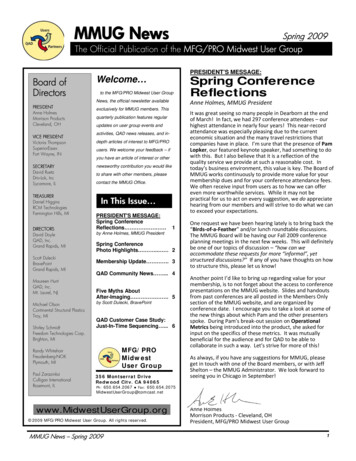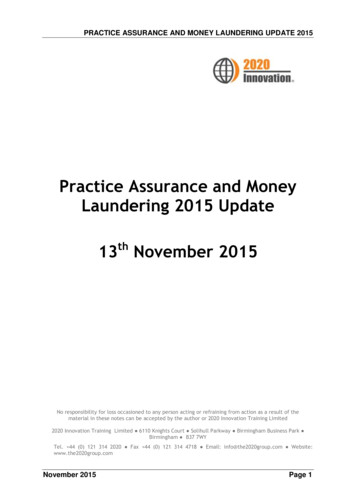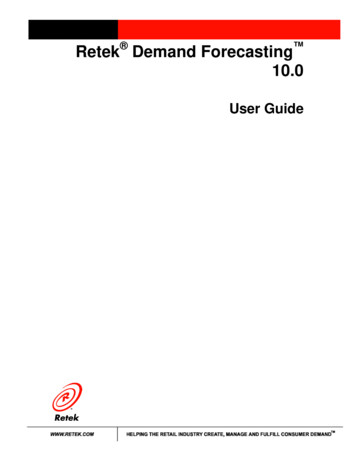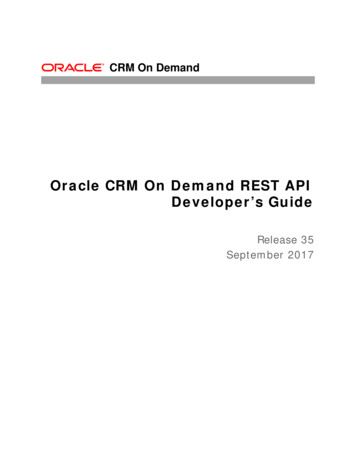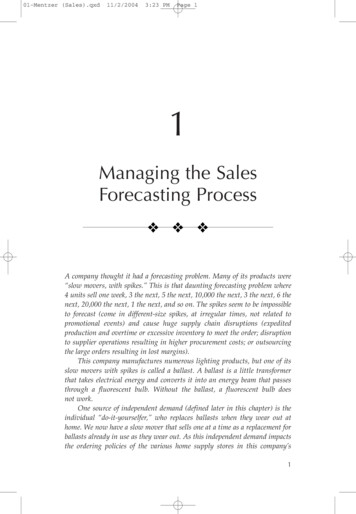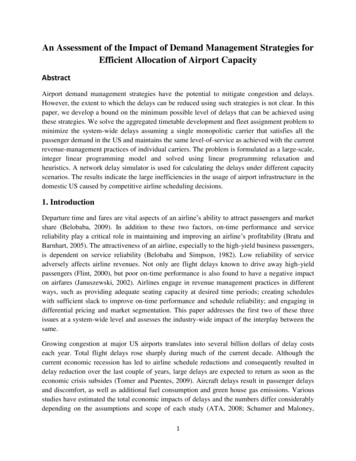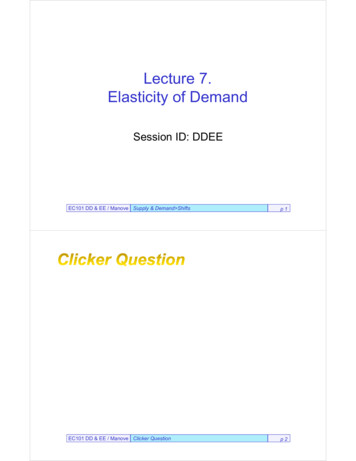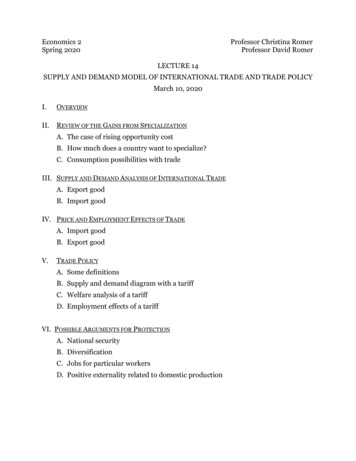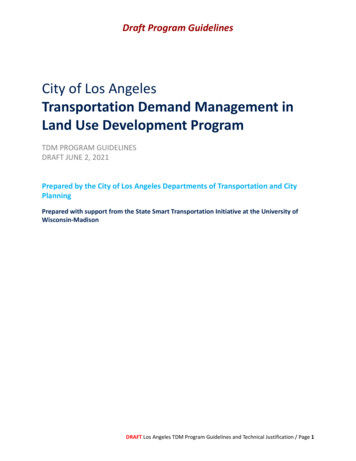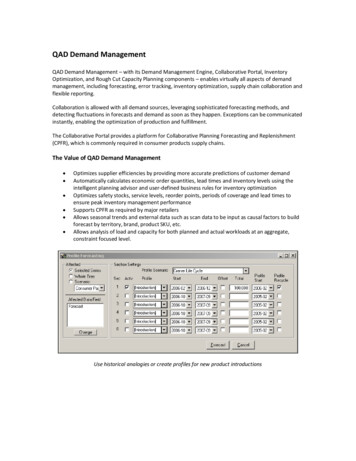
Transcription
QAD Demand ManagementQAD Demand Management – with its Demand Management Engine, Collaborative Portal, InventoryOptimization, and Rough Cut Capacity Planning components – enables virtually all aspects of demandmanagement, including forecasting, error tracking, inventory optimization, supply chain collaboration andflexible reporting.Collaboration is allowed with all demand sources, leveraging sophisticated forecasting methods, anddetecting fluctuations in forecasts and demand as soon as they happen. Exceptions can be communicatedinstantly, enabling the optimization of production and fulfillment.The Collaborative Portal provides a platform for Collaborative Planning Forecasting and Replenishment(CPFR), which is commonly required in consumer products supply chains.The Value of QAD Demand Management Optimizes supplier efficiencies by providing more accurate predictions of customer demandAutomatically calculates economic order quantities, lead times and inventory levels using theintelligent planning advisor and user-defined business rules for inventory optimizationOptimizes safety stocks, service levels, reorder points, periods of coverage and lead times toensure peak inventory management performanceSupports CPFR as required by major retailersAllows seasonal trends and external data such as scan data to be input as causal factors to buildforecast by territory, brand, product SKU, etc.Allows analysis of load and capacity for both planned and actual workloads at an aggregate,constraint focused level.Use historical analogies or create profiles for new product introductions
Key Features of the QAD Demand Management Solution Works with all versions of QAD Enterprise ApplicationsEasy to implement, learn and useStrong demand management planning core with expanded capabilitiesSales/Marketing/Finance/Operations all contribute to a single baseline forecastBetter demand visibility and inventory managementSynchronized inventory replenishmentReal-time access via the QAD Collaborative PortalRobust reporting via back-end data martSimpler planning for product introductions and retirementsOn-line and off-line forecast updatesHigh-level capacity planning for key resources such as: manpower, machinery, capital and vendor capabilitiesRough Cut load and capacity analysis, for both planned and actual work loadsBalance medium to long term demand and supply requirements.QAD Demand Management is comprised of five key components: Demand Management Engine, Collaborative Portal,Inventory Optimization, Rough Cut Planning, and Sales & Operations Planning (Basic). Features of each are explained below.Demand Management Engine Manage different data streams, such as EDI and point-of-sale dataManage plans from customers, suppliers and internal departmentsView and adjust synchronized forecasts in daily, weekly, monthly, quarterly and annual time buckets, seamlesslyswitching from one forecast to anotherAllocate changes using top-down, bottom-up, and middle-out methodologiesFilters and exceptions allow all relevant data, plan adjustments and feedback to be reconciled quicklyImproves sales forecasting and planning with an intuitive, easy-to-use GUI that captures events and promotionsand customer’s intentPowerful reporting with visibility into any layer of the business
Dynamically create hierarchies for Top Down or Bottom Up forecast calculation.Collaborative Portal Facilitates information sharing with external participants, such as sales representatives, customers and suppliers Automatic notification of exceptions to key supply chain members to ensure that potential issues are addressedquicklyEnables users to record promotions, manage by exception, do ad-hoc reporting and view data in user-defined levelsof detail Build more accurate forecasts through collaboration with sales, customers or other functional team membersInventory Optimization Automatically calculates inventory replenishment and manufacturing orders based on lead time, customer servicelevel and inventory optimization parameters
Provides automatic or user-approved purchase or manufacturing order releases based on revenue, cost and marginEnables planned inventory replenishment — monthly, weekly or daily — using synchronized time segmentsManages multi-level distribution and inventory replenishment plans by creating dynamic hierarchiesOptimizes safety stocks, service levels, reorder points, periods of coverage and lead times to ensure peak inventorymanagement performanceAutomatically calculates economic order quantities, lead times and inventory levels using the intelligent planningadvisor and user-defined business rules for inventory optimizationVary service level, desired coverage or cost to determine safety stock levelsRough Cut Capacity Planning Determines the higher-level capacity needed for key resources such as; manpower, machinery, subcontracting orcapitalAllows, via intuitive graphical interface, fine-tuning of capacity and improved visibility over factory resourcesIncludes filters to allow highly focused data searchesAnalytical reports for quick ad-hoc analysisException management reports to constrained issue immediatelyAnalyzes load and capacity for both planned and actual work loadsWhat-if analysis for fast decision making
Conversion factors that will allow for capacity to be done over by any unit of measureDrag and drop mid-term load between key resourcesSales & Operations Planning (Basic) Link medium to long term operations with business goals, operational planning, and financial planningUnite disparate sales, marketing, operations, and finance functionsModel the effect of meeting demand on your company’s supply capabilities and financial goalsBuild upon the strength of your QAD Demand Management component investmentBalance expected demand with available supply through key resources by product family or group.
QAD Demand Management ImplementationBusiness Process Review involves a review of your processes for formulating a demand plan (forecast), with emphasis onspecial situations such as introducing new products, the type of promotional activity common in your business and others.Process Measurement Review involves a review of various key measurements related to the demand management process,such as forecast accuracy, recommended safety stock levels and trend analysis. This will also include industry best practicesto help you determine if new measurements would be valuable to your organization.Application Configuration involves configuring the following Demand Management Engine and Collaborative Portalapplications to work best in your environment: Installing QAD DM and setting up the prototype environmentCreating the Living Master scenario and any required helper scenariosLoading historical data used in the formulation of a statistical forecastConfiguration of all data attributes, opinion lines, required filters and exceptionsCreation of report templates to enable process measurementsBatch Processing involves performing certain tasks on regular intervals such as data loading, forecast export to QADEnterprise Applications, etc. The Batch Scheduler will be configured to automate regular tasks or execution of a series oftasks.Typical Implementation Plan for One Site
Rough Cut load and capacity analysis, for both planned and actual work loads Balance medium to long term demand and supply requirements. QAD Demand Management is comprised of five key components: Demand Management Engine, Collaborative Portal, Inventory Optimization, Rough Cut Planning, and Sales & Operations Planning (Basic).
